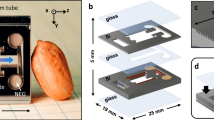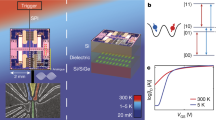Abstract
Mobile electronic devices require stable, portable and energy-efficient frequency references (or clocks). However, current approaches using quartz-crystal and microelectromechanical oscillators suffer from frequency drift. Recent advances in chip-scale atomic clocks, which probe the hyperfine transitions of evaporated alkali atoms, have led to devices that can overcome this issue, but their complex construction, cost and power consumption limit their broader deployment. Here we show that sub-terahertz rotational transitions of polar gaseous molecules can be used as frequency bases to create low-cost, low-power miniaturized clocks. We report two molecular clocks probing carbonyl sulfide (16O12C32S), which are based on laboratory-scale instruments and complementary metal–oxide–semiconductor chips. Compared with chip-scale atomic clocks, our approach is less sensitive to external influences and offers faster frequency error compensation, and, by eliminating the need for alkali metal evaporation, it offers faster start-up times and lower power consumption. Our work demonstrates the feasibility of monolithic integration of atomic-clock-grade frequency references in mainstream silicon-chip systems.
This is a preview of subscription content, access via your institution
Access options
Access Nature and 54 other Nature Portfolio journals
Get Nature+, our best-value online-access subscription
$29.99 / 30 days
cancel any time
Subscribe to this journal
Receive 12 digital issues and online access to articles
$119.00 per year
only $9.92 per issue
Buy this article
- Purchase on Springer Link
- Instant access to full article PDF
Prices may be subject to local taxes which are calculated during checkout





Similar content being viewed by others
References
Audoin, C. & Guinot, B. The Measurement of Time, Frequency and the Atomic Clock (Cambridge Univ. Press, Cambridge, 2001).
Lombardi, M. A. in The Mechatronics Handbook (ed. Bishop, R. H.) Ch. 17 (CRC Press, New York, NY, 2001).
Nguyen, C. T. C. MEMS technology for timing and frequency control. IEEE Trans. Ultrason. Ferroelectr. Freq. Control. 54, 251–270 (2007).
Fifty years of atomic time-keeping: 1955 to 2005. Special Issue. Metrologia 42, S1–S156 (2005).
Lombardi, M. A., Heavner, T. P. & Jefferts, S. R. NIST primary frequency standards and the realization of the SI second. NCSL Int. Meas. 2, 74–89 (2007).
Lutwak, R. Principles of atomic clocks. In IEEE Int. Frequency Control Symp. (IEEE, 2011).
Alzetta, G., Gozzini, A., Moi, L. & Orriols, G. An experimental method for the observation of R.F. transitions and laser beat resonances in oriented Na vapour. Nuovo Cim. B 36, 5–20 (1976).
Arimondo, E. & Orriols, G. Nonabsorbing atomic coherences by coherent two-photon transitions in a three-level optical pumping. Lett. Al Nuovo Cim. 17, 333–338 (1976).
Cyr, N., Tetu, M. & Breton, M. All-optical microwave frequency standard: a proposal. IEEE Trans. Instrum. Meas. 42, 640–649 (1993).
Vanier, J. Atomic clocks based on coherent population trapping: a review. Appl. Phys. B 81, 421–442 (2005).
Knappe, S. et al. A microfabricated atomic clock. Appl. Phys. Lett. 85, 1460–1462 (2004).
Lutwak, R. et al. The chip-scale atomic clock—prototype evaluation. In 39th Ann. Precise Time and Time Interval Meeting 269–290 (ION, 2007).
Youngner, D. et al. A manufacturable chip-scale atomic clock. In Solid-State Sensors, Actuators and Microsystems Conference 2007, 39–44 (IEEE, 2007).
DeNatale, J. et al. Compact, low-power chip-scale atomic clock. In Position, Location and Navigation Symposium 2008, 67–70 (IEEE, 2008).
Haesler, J. et al. The integrated Swiss miniature atomic clock. In Joint European Frequency and Time Forum & International Frequency Control Symposium (EFTF/IFC) 2013, 579–581 (IEEE, 2013).
Quantum SA.45s chip scale atomic clock (Microsemi, 2017); https://www.microsemi.com/document-portal/doc_download/133305-sa-45s-csac-datasheet
Riley, W. Handbook of Frequency Stability Analysis (NIST, Gaithersburg, MD, 2008).
Shock and vibration testing of the SA.45s chip scale atomic clock (CSAC) validation build units (Microsemi, 2014); https://www.microsemi.com/document-portal/doc_download/133153-shock-and-vibration-testing-of-the-sa-45s-chip-scale-atomic-clock-csac-validation-build-units
Good, W. E. The inversion spectrum of ammonia. Phys. Rev. 70, 213–218 (1946).
Smith, W. V., Quevedo, J. L. G. D., Carter, R. L. & Bennett, W. S. Frequency stabilization of microwave oscillators by spectrum lines. J. Appl. Phys. 18, 1112–1115 (1947).
Hershberger, W. D. & Norton, L. E. Frequency stabilization with microwave spectral lines. RCA Rev. 9, 38–49 (1948).
Townes, C. H. Atomic clocks and frequency stabilization on microwave spectral lines. J. Appl. Phys. 22, 1365–1372 (1951).
Gordon, J. P., Zeiger, H. J. & Townes, C. H. Molecular microwave oscillator and new hyperfine structure in the microwave spectrum of NH3. Phys. Rev. 95, 282–284 (1954).
Wineland, H. D. A., David, J. & Hellwig, H. Special purpose atomic (molecular) standard. In Proc. Eighth Annual Precise Time and Material Interval Applications and Planning Meeting 429–448 (IEEE, 1977).
Townes, C. H. & Schawlow, A. L. Microwave Spectroscopy (Courier Corporation, Chelmsford, MA, 2013).
Wineland, D. J., Howe, D. A. & Mohler, M. B. Results with the special-purpose ammonia frequency standard. In 31st Ann. Symp. on Frequency Control 1977, 562–573 (IEEE, 1977).
Wang, C. & Han, R. Rapid and energy-efficient molecular sensing using dual mm-wave combs in 65 nm CMOS: a 220-to-320 GHz spectrometer with 5.2 mW radiated power and 14.6-to-19.5 dB noise figure. In International Solid-State Circuit Conference (ISSCC), 18–20 (IEEE, 2017).
Ferm, R. J. The chemistry of carbonyl sulfide. Chem. Rev. 57, 621–640 (1957).
Cox, J. T. & Gordy, W. Zeeman effect of some linear and symmetric-top molecules. Phys. Rev. 101, 1298–1304 (1956).
Vanier, J. & Bernier, L.-G. On the signal-to-noise ratio and short-term stability of passive rubidium frequency standards. IEEE Trans. Instrum. Meas. 1001, 277–282 (1981).
Karplus, R. & Schwinger, J. A note on saturation in microwave spectroscopy. Phys. Rev. 73, 1020–1026 (1948).
Supplee, J. M., Whittaker, E. A. & Lenth, W. Theoretical description of frequency modulation and wavelength modulation spectroscopy. Appl. Opt. 33, 6294–6302 (1994).
Wang, C. et al. CMOA molecular clock probing 231.061-GHz rotational line of OCS with sub-ppb long-term stability and 66-mW dc power. In 2018 Symp. on VLSI Technology and Circuits (IEEE, 2018).
Wang, C. et al. Robust sub-harmonic mixer at 340 GHz using intrinsic resonances of hammer-head filter and improved diode model. J. Infrared Millim. Terahertz Waves 38, 1397–1415 (2017).
Jet Propulsion Laboratory molecular spectroscopy catalog; https://spec.jpl.nasa.gov/
Hati, A., Nelson, C. & Howe, D. in Aerial Vehicles 259–286 (In-Tech, Vienna, 2009).
Koshelev, M. A., Tretyakov, M. Y., Rohart, F. & Bouanich, J.-P. Speed dependence of collisional relaxation in ground vibrational state of OCS: rotational behaviour. J. Chem. Phys. 136, 124316 (2012).
Yang, S. H., Baek, K. J., Kwon, T. Y., Kim, Y. B. & Lee, H. S. Second-order Zeeman frequency shift in the optically pumped cesium beam frequency standard with a dual servo system. Jpn J. Appl. Phys. 38, 6174–6177 (1999).
GATS, I. Spectral Calculator; http://www.spectralcalc.com
Acknowledgements
The authors thank S. Coy (MIT, Department of Chemistry), R. Field (MIT, Department of Chemistry), D. Buss (Texas Instruments and MIT, Department of Electrical Engineering and Computer Science), B. Perkins (MIT Lincoln Labs), J. Muenter (University of Rochester, Department of Chemistry) and P. Nadeau (MIT, Department of Electrical Engineering and Computer Science) for helpful technical discussions. The authors also thank Y. Zhang and K. Nelson (MIT, Department of Chemistry) for help with OCS preparation and other technical support. This work was supported by an NSF CAREER award (ECCS-1653100), MIT Lincoln Laboratory, MIT Center of Integrated Circuits and Systems, and a Texas Instrument Fellowship.
Author information
Authors and Affiliations
Contributions
C.W. and R.H. conceived and designed the research. C.W. constructed the two prototypes (including the laboratory-scale and chip-scale molecular clocks). X.Y. conducted the design of the VCXO and analysis of the clock-loop dynamics. C.W., M.K. and Z.W. conducted spectroscopy experiments. C.W. and J.M. conducted clock stability characterization. C.W. and R.H. analysed the data and wrote the manuscript. All authors reviewed the manuscript.
Corresponding author
Ethics declarations
Competing interests
The authors declare no competing interests.
Additional information
Publisher’s note: Springer Nature remains neutral with regard to jurisdictional claims in published maps and institutional affiliations.
Rights and permissions
About this article
Cite this article
Wang, C., Yi, X., Mawdsley, J. et al. An on-chip fully electronic molecular clock based on sub-terahertz rotational spectroscopy. Nat Electron 1, 421–427 (2018). https://doi.org/10.1038/s41928-018-0102-4
Received:
Accepted:
Published:
Issue Date:
DOI: https://doi.org/10.1038/s41928-018-0102-4
This article is cited by
-
Low phase noise THz generation from a fiber-referenced Kerr microresonator soliton comb
Communications Physics (2022)
-
Optically referenced 300 GHz millimetre-wave oscillator
Nature Photonics (2021)
-
A CMOS-integrated quantum sensor based on nitrogen–vacancy centres
Nature Electronics (2019)
-
Molecular clock redux in miniature
Nature Electronics (2018)



